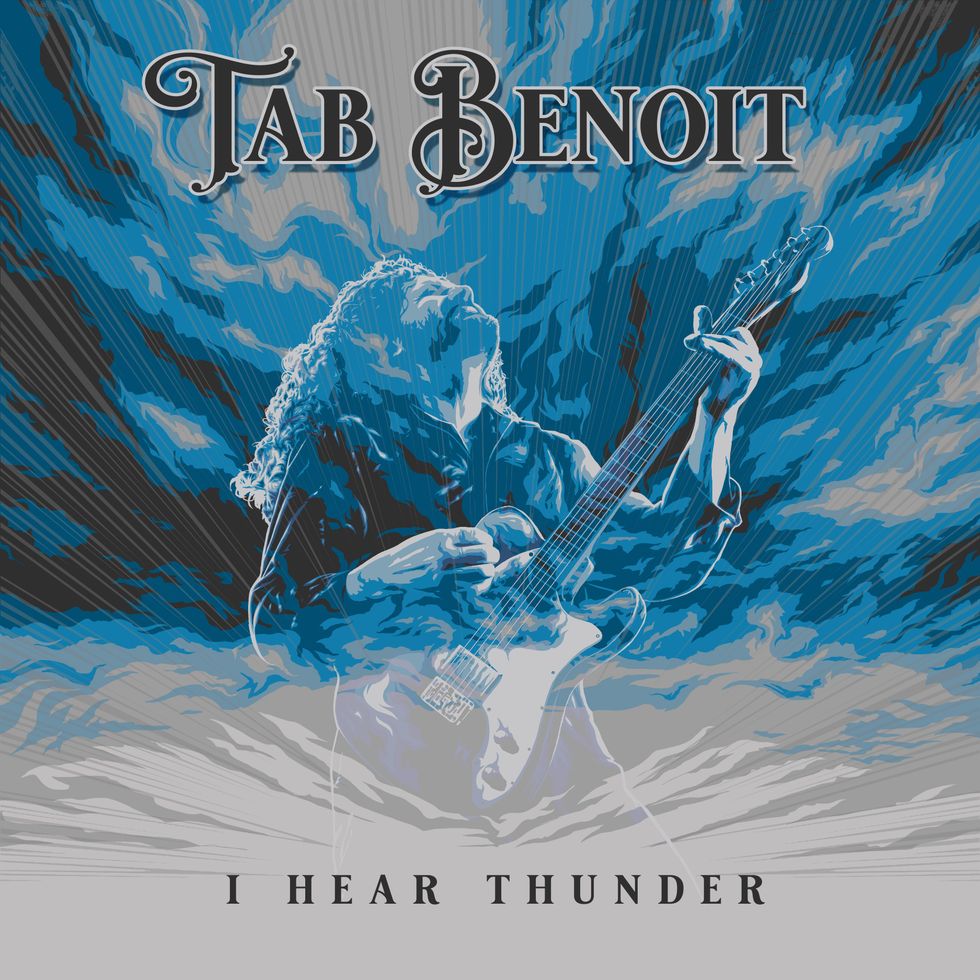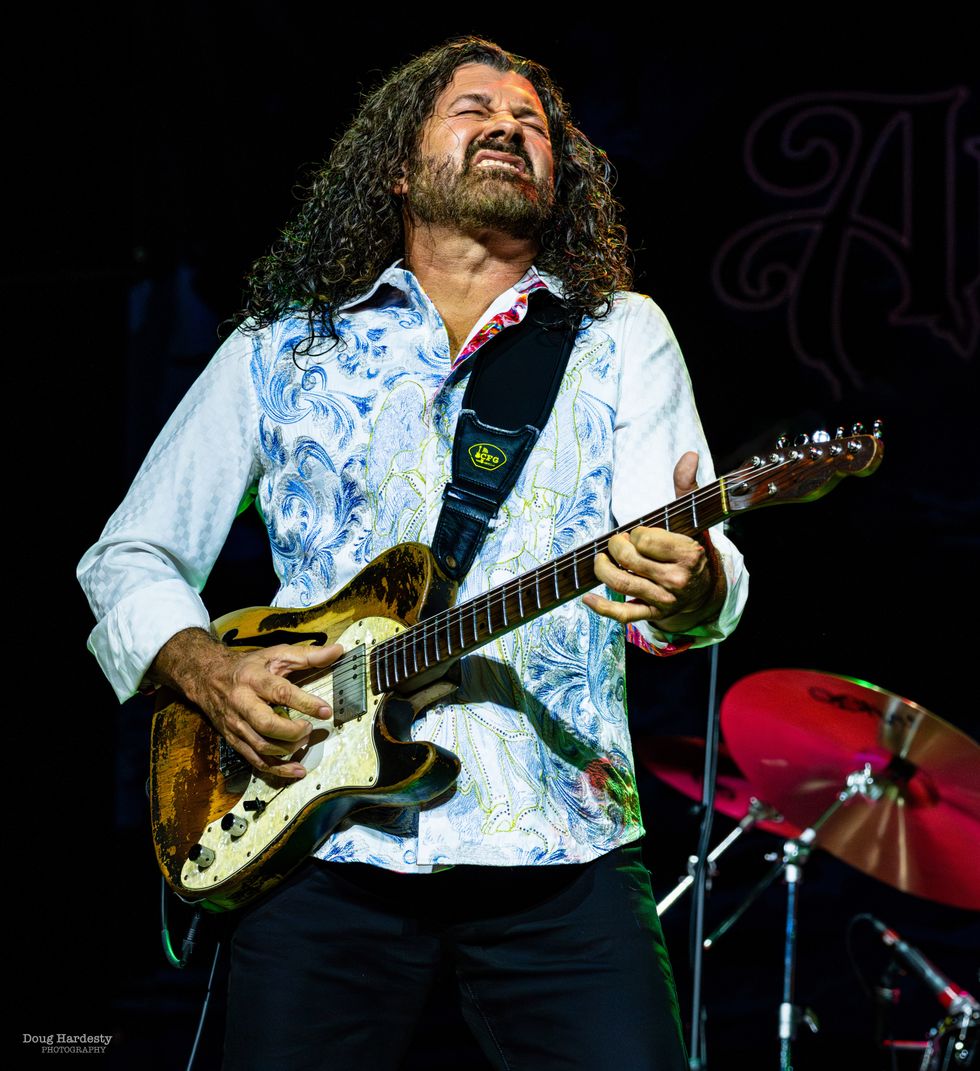The words “honesty” and “authenticity” recur often during conversation with Tab Benoit, the Houma, Louisiana-born blues vocalist, guitarist, and songwriter. They are the driving factors in the projects he chooses, and in his playing, singing, and compositions. Despite being acclaimed as a blues-guitar hero since his ’80s days as a teen prodigy playing at Tabby Thomas’ legendary, downhome Blues Box club in Baton Rouge, Benoit shuns the notion of stardom. Indeed, one might also add simplicity and consistency as other qualities he values, reflected in the roughly 250 shows a year he’s performed with his hard-driving trio for over two decades, except for the Covid shutdown.
On his new I Hear Thunder, Benoit still proudly plays the Fender Thinline Telecaster he purchased for $400 when he was making his debut album in Texas, 1992’s Nice & Warm. After that heralded release, his eclectic guitar work—which often echoes between classic blues-rock rumble-and-howl, the street-sweetened funk of New Orleans, and Memphis-fueled soul—helped Benoit win a long-term deal with Justice Records. But when the company folded in the late ’90s, his contract and catalog bounced from label to label.
Tab Benoit - "I Hear Thunder"
This bucked against Benoit’s strong desire to fully control his music—one reason he settled on the trio format early in his career. And although his 2011 album, Medicine, won three Blues Music Awards—the genre’s equivalent of Grammys—he stopped recording as a leader because he was bound by the stipulations of a record deal, now over, that he deemed untenable.
“I wanted to make records that reflected exactly how I sounded live and that were done as though we were playing a live concert,” Benoit says. “So, I formed my own label [Whiskey Bayou Records, with partner Reuben Williams] and signed artists whose music was, to me, the real deal, honest and straightforward. I couldn’t do anything on my own, but I could still continue putting out music that had a positive impact on the audience.”

Benoit’s new album, which includes Anders Osborne and George Porter Jr., was recorded in the studio at the guitarist’s home near the bayou in Houma, Louisiana.
Those artists include fellow rootsers Eric McFadden, Damon Fowler, Eric Johanson, Jeff McCarty, and Dash Rip Rock. Benoit also spent plenty of time pursuing his other passion: advocating for issues affecting Louisiana’s wetlands, including those around his native Houma. His 2004 album was titled Wetlands, and shortly after it was issued he founded the Voice of the Wetlands non-profit organization, and later assembled an all-star band that featured New Orleans-music MVPs Cyril Neville, Anders Osborne, George Porter Jr., Big Chief Monk Boudreaux, Johnny Vidacovich, Johnny Sansone, and Waylon Thibodeaux. This ensemble, the Voice of the Wetlands All-Stars, has released multiple CDs and toured.
Essentially, Benoit comes from the bayous, and when it’s time to record, he goes back to them, and to the studio he has in Houma, which he refers to as “the camp.” That’s where I Hear Thunder came to life. “George and Anders came to me and said, ‘Let’s go make some music,” Benoit offers. “So, we went out to the camp. They had some songs—and George and Anders and I go back so many years it was really a treat to put everything together. It only took us a couple of days to do everything we needed to do.”
“George Porter and Anders Osborne and I saw this alligator sitting around the boat where we were writing the entire time. I guess he really liked the song.”
I Hear Thunder has become his first number one on Billboard’s blues chart. Besides the fiery-yet-tight and disciplined guitar work of Benoit and Osborne, the latter also an esteemed songwriter, the album features his longtime rhythm section of bassist Corey Duplechin and drummer Terence Higgins. Bass legend Porter appears on two tracks, “Little Queenie” and “I’m a Write That Down.” Throughout the album, Benoit sings and plays with soul and tremendous energy, plus he handled engineering, mixing, and production.
Once again, that ascribed to his aesthetic. “My main reason for taking on those extra duties was I wanted to make sure that this recording gives the audience kind of a preview of how we’re going to sound live,” he declares. “That’s one of the things that I truly don’t like about a lot of current recordings. I listen to them and then see those guys live and it’s like, ‘Hey, that doesn't sound like what was on the album.’ Play it once or twice and let’s run with it. Don’t overdo it to the point you kill the honesty. All the guys that I love—Lightnin’ Hopkins, Albert King—they played it once, and you better have the tape machine running because they’re only going to give it to you that one time. That’s the spontaneity that you want and need.
“One of the reasons I don’t use a lot of pedals and effects is because I hate gimmicks,” he continues. “ I’m playing for the audience the way that I feel, and my attitude is ‘Let’s plug into the guitar and let it rip. If I make a mistake, so be it. I’m not using Auto-Tune to try and get somebody’s vocal to seem perfect. You think John Lee Hooker cared about Auto-Tune? You’re cheating the audience when you do that stuff.”
Tab Benoit’s Gear

Benoit in 2024 with his trusty 1972 Fender Thinline Telecaster, purchased in 1992 for $400. Note that Benoit is a fingerstyle player.
Photo by Doug Hardesty
Guitar
- 1972 Fender Telecaster Thinline
Amp
- Category 5 Tab Benoit 50-watt combo
Strings
- GHS Boomers (.011–.050)
The I Hear Thunder songs that particularly resonate include the explosive title track, the soulful “Why, Why” and the rollicking “Watching the Gators Roll In,” a song that directly reflected the album’s writing experience and environment. “George and Anders and I saw this alligator sitting around the boat where we were writing the entire time. I guess he really liked the song. He’d be swimming along and responding. That gave it some added punch.” As does Benoit and Osborne’s consistently dynamic guitar work. “I’m not one of these people who want to just run off a string of notes or do a lot of fast playing,” Benoit says. “It has to fit the song, the pace, and most of all, really express what I’m feeling at that particular moment. I think when the audience comes to a show and you play the songs off that album, you’ve got to make it real and make it honest.”
When asked whether he ever tires of touring, Benoit laughs and says, “Absolutely not. At every stop now I see a great mix of people who’ve been with us since the beginning, and then their children or sometimes even their grandchildren. When people come up to you and say how much they enjoy your music, it really does make you feel great. I’ve always seen the live concerts as a way of bringing some joy and happiness to people over a period of time, of helping them forget about whatever problems or issues they might have had coming in, and just to enjoy themselves. At the same time, I get a real thrill and joy from playing for them, and it’s something that I always want the band’s music to do—help bring some happiness and joy to everyone who hears our music.”
YouTube It
Hear Tab Benoit practice the art of slow, soulful, simmering blues on his new I Hear Thunder song “Overdue,” also featuring his well-worn 1972 Telecaster Thinline.






















![Rig Rundown: AFI [2025]](https://www.premierguitar.com/media-library/youtube.jpg?id=62064741&width=1245&height=700&quality=70&coordinates=0%2C0%2C0%2C0)












![Devon Eisenbarger [Katy Perry] Rig Rundown](https://www.premierguitar.com/media-library/youtube.jpg?id=61774583&width=1245&height=700&quality=70&coordinates=0%2C0%2C0%2C0)






